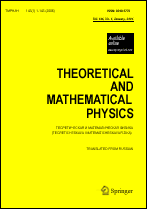|
This article is cited in 1 scientific paper (total in 1 paper)
Influence of anisotropic rheology on wave processes in sea ice
A. V. Marchenko
The University Centre in Svalbard, Longyearbyen, Norway
Abstract:
The Burgers model is adapted to the description of viscoelastic rheology of ice and used for the investigation of dispersion and attenuation of waves propagating in a water layer beneath solid columnar ice. Rheological constants describing the ice properties in the horizontal direction are obtained from the experiments with cores of natural columnar sea ice. Energy dissipation in the boundary layer under the ice is regarded as an additional mechanism of wave attenuation. The dependence of the wave attenuation coefficient on the wavelength is investigated. We find that viscous properties of ice are most important for the attenuation of waves with periods less 10 s. Dissipation of wave energy in the boundary layer under the ice dominates as the wave period increases from 10 s to 30 s. Long infragravity waves with periods 20–30 s can propagate over long distances with insignificant attenuation when turbulence in the boundary layer under the ice is small.
Keywords:
flexural-gravity waves, ice, energy dissipation, attenuation, viscosity, anelasticity, turbulence, eddy viscosity.
Received: 07.01.2022
Revised: 07.01.2022
Citation:
A. V. Marchenko, “Influence of anisotropic rheology on wave processes in sea ice”, TMF, 211:2 (2022), 264–280; Theoret. and Math. Phys., 211:2 (2022), 665–678
Linking options:
https://www.mathnet.ru/eng/tmf10242https://doi.org/10.4213/tmf10242 https://www.mathnet.ru/eng/tmf/v211/i2/p264
|


| Statistics & downloads: |
| Abstract page: | 243 | | Full-text PDF : | 67 | | References: | 83 | | First page: | 13 |
|




 Contact us:
Contact us: Terms of Use
Terms of Use
 Registration to the website
Registration to the website Logotypes
Logotypes









 Citation in format
Citation in format 